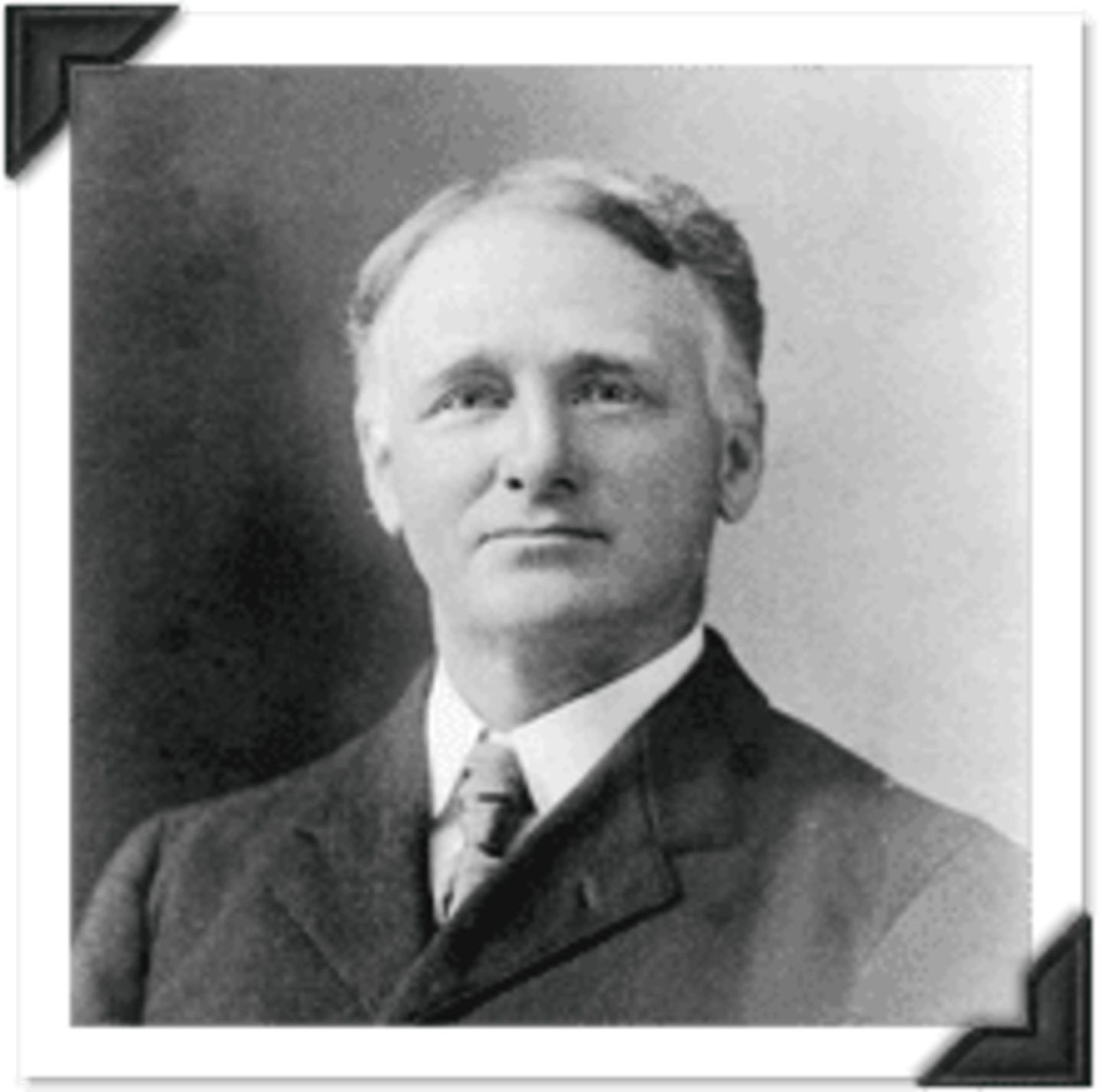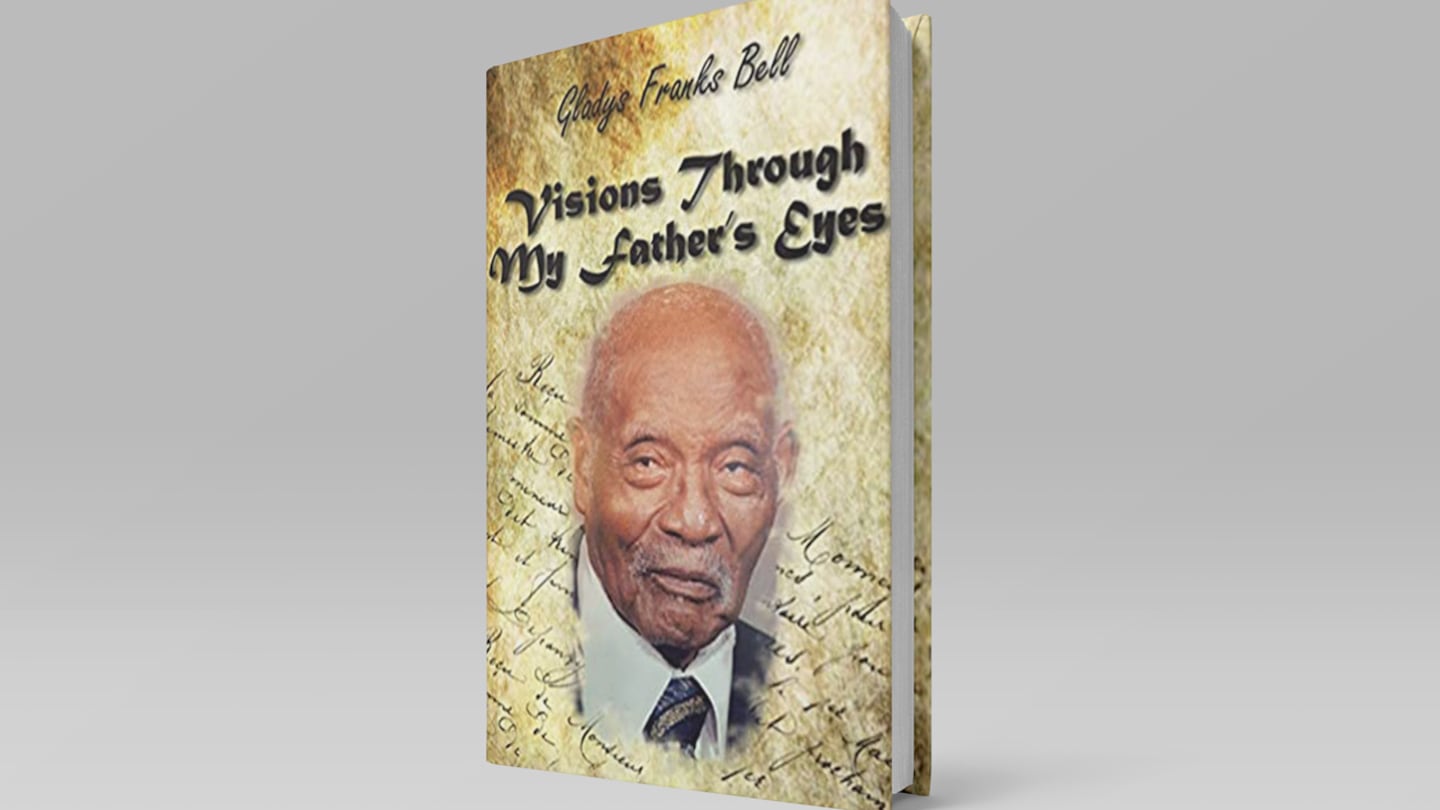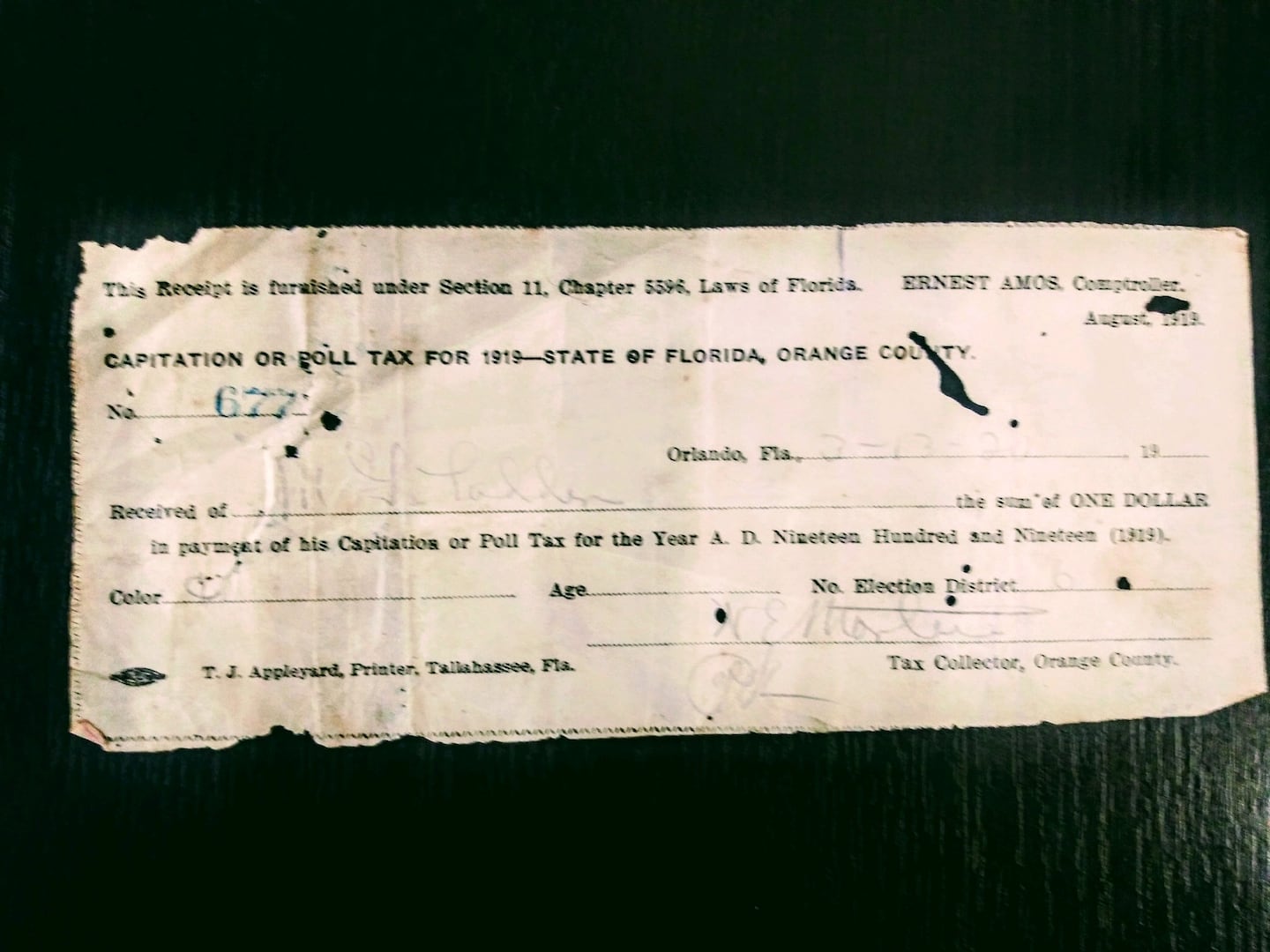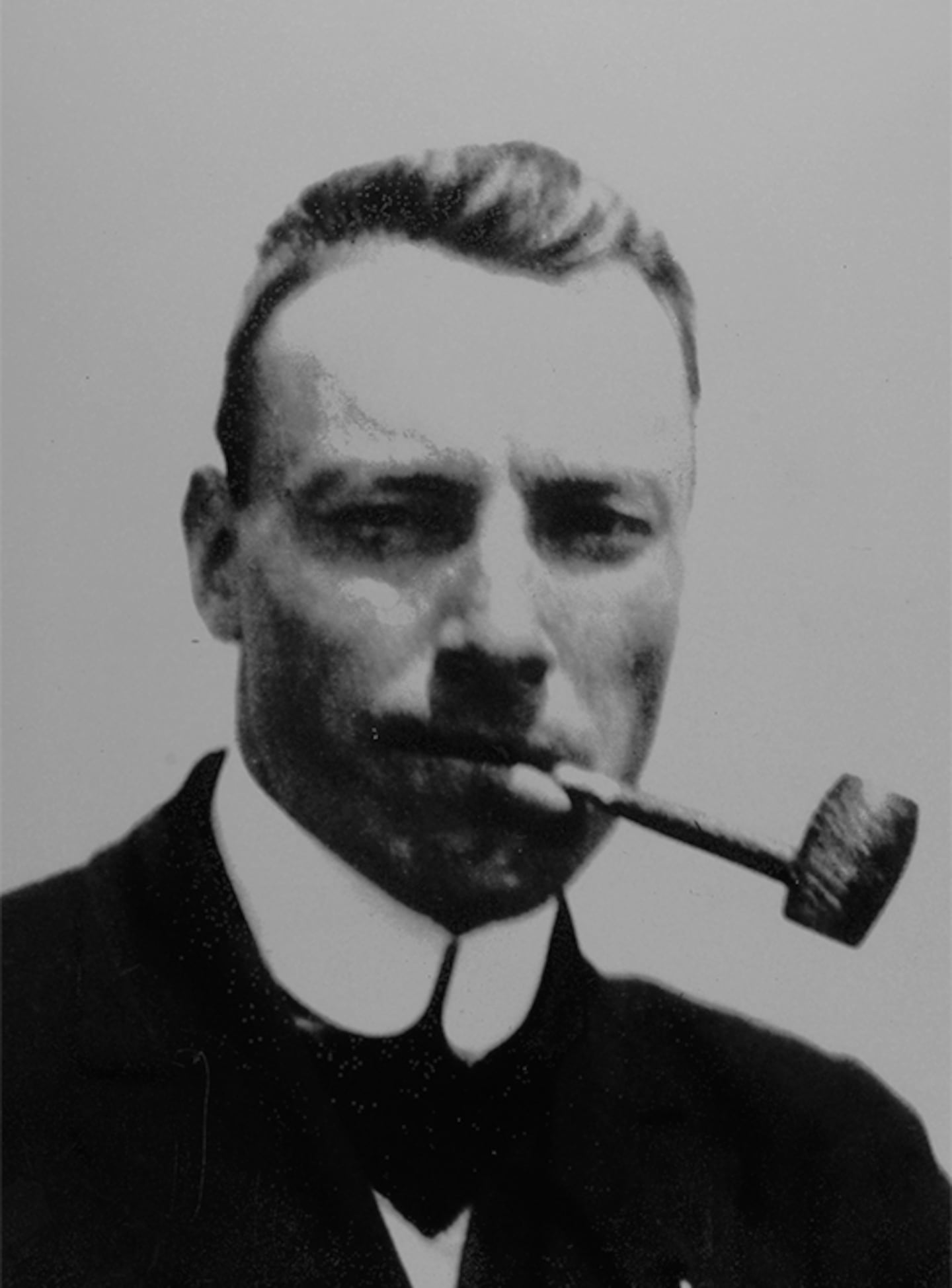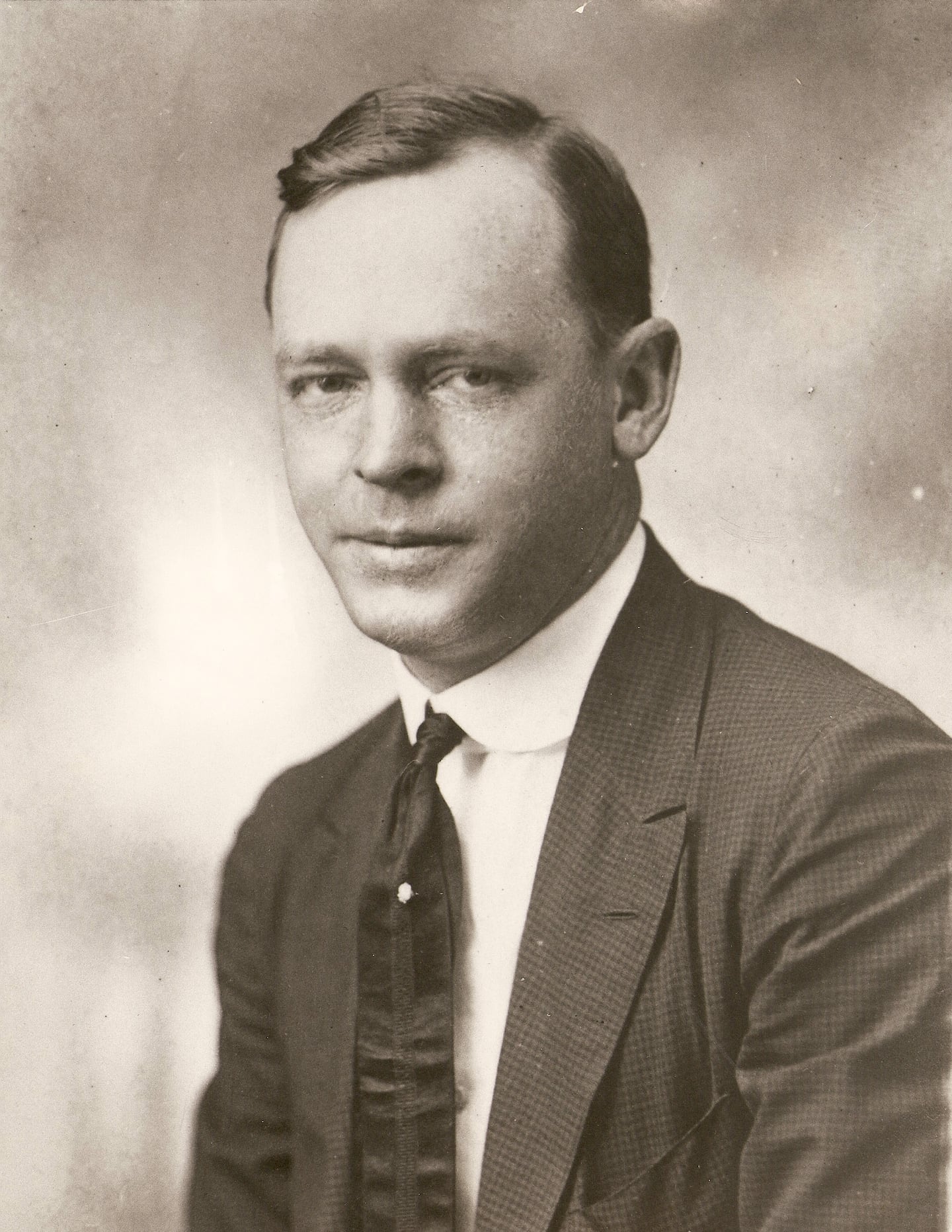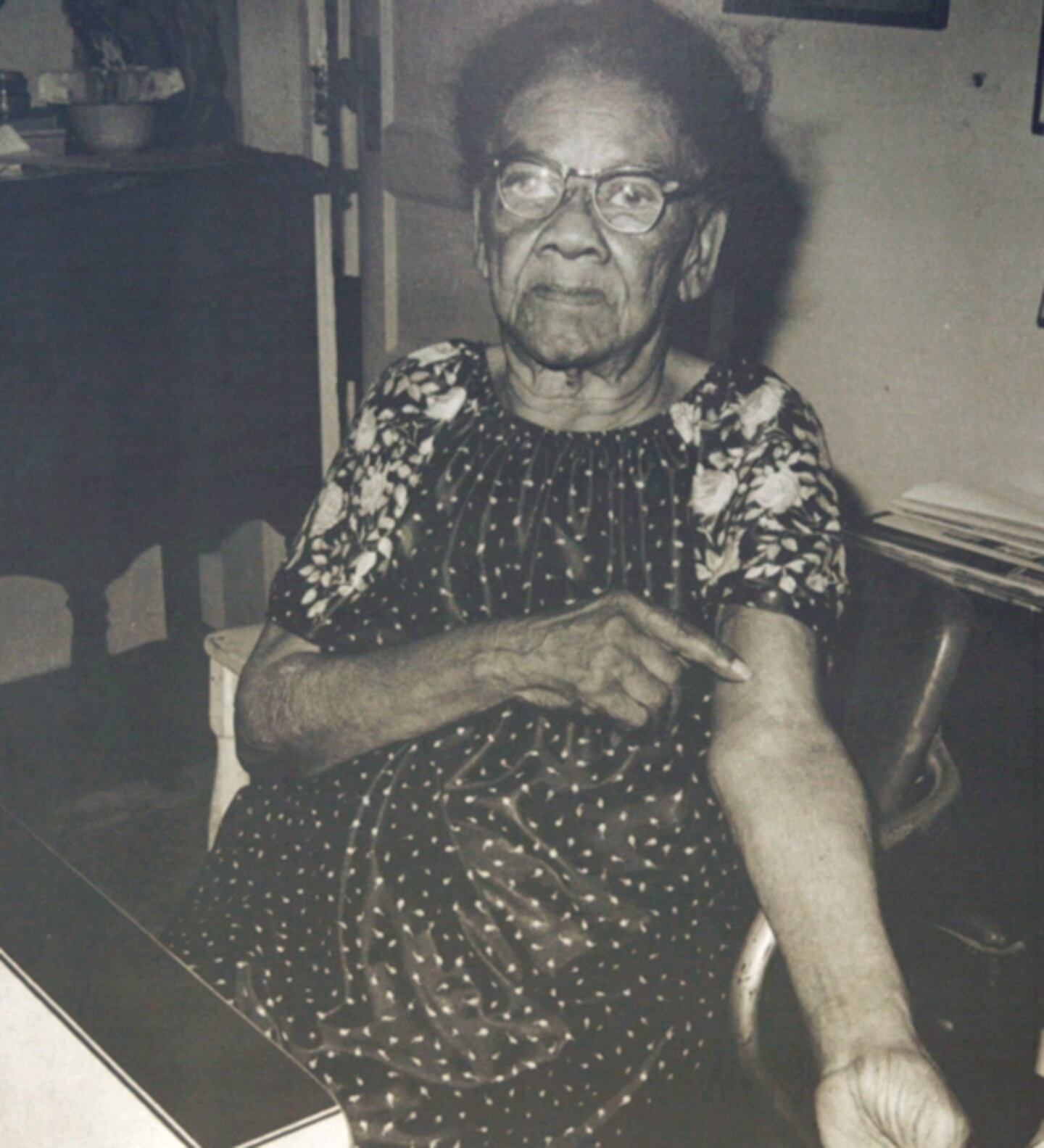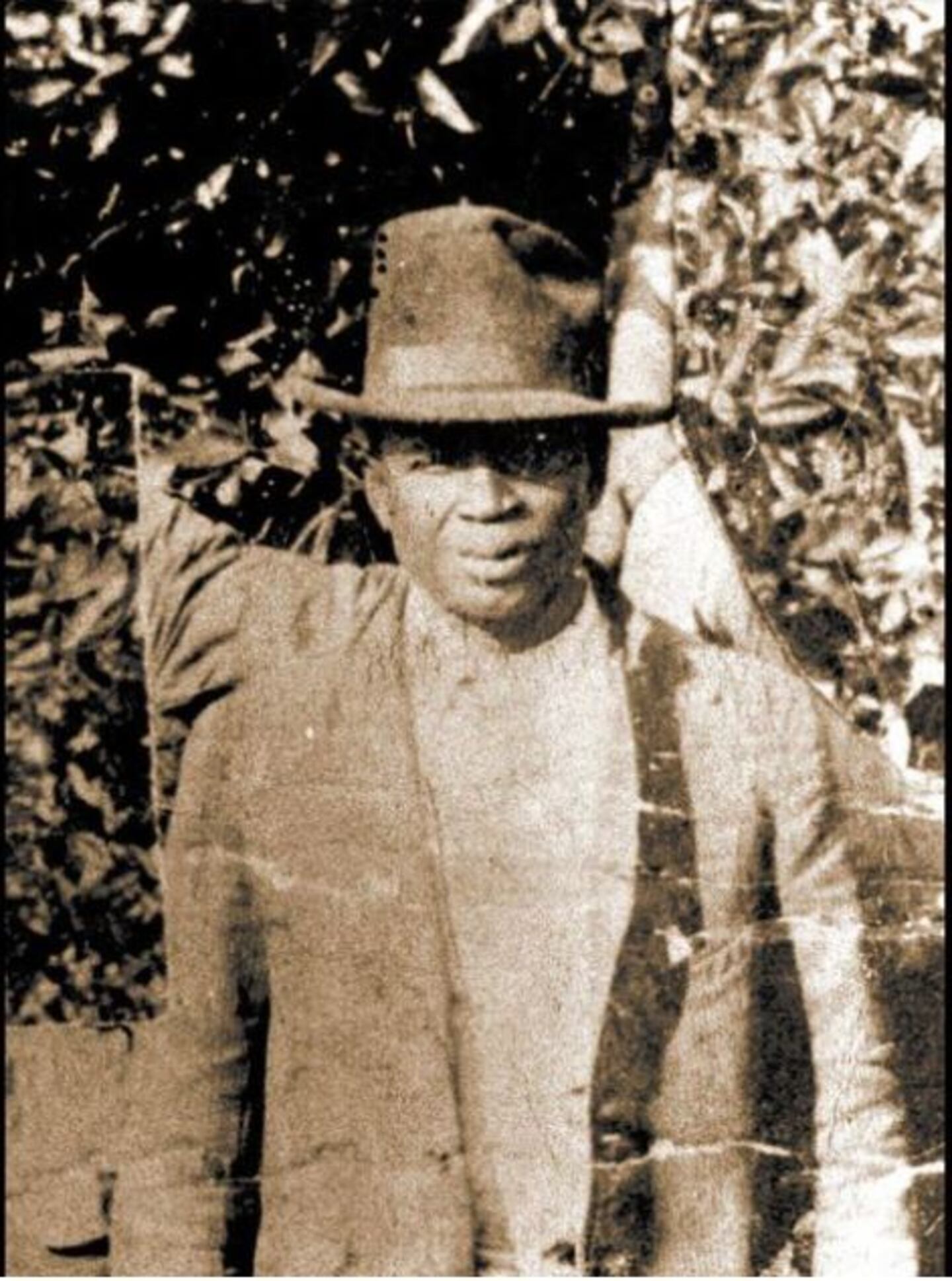The angry white mob surrounded Julius ‘July’ Perry’s Ocoee home. Someone attempted to enter, pounded him on the head and there was a gunfight. Perry tried desperately to defend his family. But Perry eventually realized this was a gunfight he would never win. His daughter Coretha, trained with firearms, was taking shots at his side, perhaps even wounding one of the men attacking them.
“At some point he looked at her and said, Coretha, you’ve got to get out of here and take your mom and your siblings to safety,” Stephen Nunn, July Perry’s great-grandson said, recalling his grandmother’s retelling of the episode.
“And she said she was crying,” Nunn explained. “And she was saying, ‘No, Papa, no pop. I’m not going to leave you, no Papa,’…She was really right there with him. And she’d say, he said, ‘no, Coretha, you got to go. I can’t leave. I’m not going to leave here. I’m staying, but you’ve got to go.'"
With that direction, Julius ‘July’ Perry saved his family, but sealed his fate. It would soon be the bloody, tragic end of a day that was supposed to have marked the emergence of Perry and other ambitious young Black men attempting to fulfill America’s promise – freedom, prosperity and the right to vote.
Orange County of 1920
The Orange County of 1920 was nothing like the Greater Orlando of 2020. No high-rises downtown. No tourist attractions. But the region, especially the area around Lake Apopka, was a booming agricultural hotspot, filled with fruit of opportunity.
Many Black people relocated there, discovering they could make much more money filling up boxes of citrus than picking cotton in other parts of the South.
“Ocoee of the early 1900s was bursting economically because of its fertile ground in and around Lake Apopka,” said Francina Boykin, a member of Democracy Forum, a grassroots group set up in 1996 to research and seek answers about the Ocoee massacre. “Many people were moving here from the Carolinas, Georgia…and Northern parts of Florida, coming to an area that had been described as one that would be economically stable and enriching for those who are wanting to make a better life for themselves and their families.”
The Black Vote
Two men enjoying the rewards of their hard work in Ocoee’s bustling agri-business were Julius ‘July’ Perry and his business partner Moses ‘Mose’ Norman.
Ahead of the Nov. 2 election, Republicans were actively courting the Black vote and especially influential Black men, like Perry and Norman, who had paid their poll taxes.
“So that was going to be a very exciting time to be able to vote now,” Boykin said. “You know, you were landowners. You could do everything but cast that vote.”
Since Reconstruction, Florida had been dominated politically by the Democrats. Yet, Judge John Moses Cheney, a Republican running for the Senate, began the voter registration campaign for Black residents in Orange County.
Leaders in his party believed Black voters would be loyal to Republicans since President Abraham Lincoln, a Republican, had freed the slaves. And Blacks were registering in record numbers across the South. But in the weeks leading up to the election members of the Ku Klux Klan warned Blacks in the area that they would not be permitted to vote.
Some anticipated the violence that would eventually come to pass.
The Plan to Vote
Gladys Bell’s grandfather, Richard Allen Franks, had migrated to Ocoee from South Carolina. She recounts the stories he shared in her book, ‘Vision Through My Father’s Eyes.’ “News had gotten around that July Perry and Mr. Norman, they were going to vote,” Bell said. “And they knew that the whites did not want the Blacks to vote.”
So Bell explained that her grandfather and grandmother developed an escape plan.
“They knew that if he could get his children and them to Plymouth (FL), they would be safe and welcome,” Bell said.
Bell’s relatives escaped the mob and the gunfire terrorizing Ocoee’s Black communities, she said, by walking through the darkness, guided by the moonlight, through the swampland surrounding Lake Apopka, the very land that had initially attracted Blacks and whites to the rural area.
“My dad said they had met. His dad had told him, ‘Stay in the bushes. Stay out of sight because the Klansmen will be shooting anything they see, anybody they see,’” Bell said.
The incident that directly led to the night and subsequent days of terror in Ocoee was Moses Norman being denied his legal right to vote at the polling place, because he was told there was no record of him paying his poll tax. Poll taxes were dominate in the South and used to get around the 14th amendment, which guaranteed citizenship to anyone born or naturalized in the United States, including former slaves. It was one of three amendments passed during Reconstruction to abolish slavery.
The poll tax was a voting fee that started in the 1890s to keep Blacks from voting in the south. Even though they were eligible to vote they were required to pay the tax. The use of poll taxes for federal elections continued until 1964. And even then, five states enforced the tax for state elections until 1966, when the U.S. Supreme Court stepped in.
Prior to the poll tax, other measures, called, ‘Black Codes’ were enacted in southern states. The laws were designed to limit the freedom of African Americans and put a value on their labor after slavery was abolished.
Florida Black Codes by WFTV on Scribd
After being refused at the poll in Ocoee, most accounts are that Norman went to see Judge Cheney, who told him to go back and exercise his right to vote. After all, Cheney said, Norman had paid his poll tax. “So when Moses Norman returns, as we’ve been told or found in some of our research, he goes back and you know, he gets into a fight or a scuffle,” Boykin said. “So he’s heading out of dodge. Now he goes by to July, ‘Hey man, I’m out of here. I’m gone.’”
And that was the end of Norman’s time in Ocoee and Florida. He left, never to be seen here again. There are accounts that he ended up in New York City, where he later died.
The Lynch Mob
But when word spread about Norman’s attempts to vote, a posse and what became a lynch mob was formed under the leadership of Colonel Sam Salisbury, who was the former Orlando police chief at the time. Salisbury, who also attended the United States Military Academy, West Point, would be elected Mayor of Ocoee in 1951. A thesis published by former Ocoee Mayor and high school principal, Lester Dabbs, based on interviews with those involved in the confrontation, provides an accounting that Clyde Pounds, a deputy sheriff, deputized some 20 men to investigate what they viewed as “trouble” at Perry’s home. Another source told Dabbs that Sheriff Frank Gordon came out and legalized the group.
Knowing Norman’s close associate and partner in registering Black voters, the mob ended up at Perry’s doorstep. While members of the mob were deputized before the encounter, Boykin insisted they had no legal authority to go to Perry’s home that night and confront him.
“You would probably call it a home invasion today,” she said.
Stephen Nunn, Julius Perry’s great-grandson, said Perry told the mob leaders the man they were looking for was not in his home. “My grandmother said her dad in that conversation he was pretty much telling them, ‘I don’t know what you’re talking about and no one’s in here, but me and my family, and I’m not coming out there, but you’re not coming in here either,’” Nunn said.
Dabbs recounts in his interviews that Col. Salisbury pounded Perry on the head with the butt of an Enfield rifle as he held him by the neck.
The gunfight escalated, and Nunn said his grandmother began engaging the men storming the home with her own shotgun or rifle. A shot was fired and hit Salisbury in the forearm. Two other white men, Leo Borgard and Elmer McDaniels. were killed in the gun fight.
“You just pray, you just pray.”
— Stephen Nunn
“At some point she said there was so much gunfire, you could see the tracers of the bullets flying through the house,” he said.
July Perry was wounded and even Nunn’s grandmother, Coretha, suffered a bullet wound to her arm, which she later showed a local reporter when she was interviewed about the encounter decades later and before her death. Soon Perry was imploring his daughter to leave with the rest of their family. Nunn said she asked her father, “How are we going to get out?”
“And she said, he said something to the effect, ‘Coretha, you just pray, you just pray, but you’ve got to get your mom and kids out of here.’”
His grandmother remembered escaping the home with her mother and siblings through a door with a “cat hole.” She remembered looking back at her father “still working his rifle,” Nunn said. She was torn, he said, between wanting to stay by her father’s side and saving the rest of her family. Once outside the home, his grandmother said she spotted a beam of moonlight shining on the field.
“And so, she was like, Oh my God. And she said, she put her mother and the kids and all of them got on their stomachs and they began to crawl,” Nunn said.
“She said she knew that it was a sign from God,” he explained. “As they were crawling through this field, she said, we could see the feet, the boots, the shoes of people from the township that were shooting into the house and shooting their father. We could see their feet, but they never saw us.”
It’s unclear what happened to the other Perry children. But Coretha and her mother, Estelle, were captured and arrested. They were ordered never to return to Orange County, and were taken to a jail in Tampa. They were later released and lived in the area until their deaths.
The writer Zora Neale Hurston later recounted what she had heard about the massacre in a published magazine article, ‘The Ocoee Riot.’
“The mob did not know that Norman had only spent a few minutes at the Perry home and then fled.” Hurston wrote in gruesome detail the accounts she learned about the shootout at Perry’s home. "A woman and her daughter were killed, and their bodies left and partially burned by the flames that consumed their former home. The daughter was far advanced in pregnancy, Hurston wrote.
Another man died of fire and gunshot wounds when the barn of July Perry was set on fire. “He had thought that that would be a good hiding place, but when the fury of the crowd swept over the Perry place, the barn was fired and when (he) tried to rush out he was driven back by a bullet to die in the fire,” Hurston wrote in her account.
July Perry was eventually apprehended. Oral accounts from historians and descendants vary, on whether he was dragged by a car into Orlando, where received medical treatment at the jail or hospital. There are some accounts that he was dragged by a car with his injuries, when an angry mob of whites from all over the state, overtook the jailer, and grabbed Perry from his jail cell.
“And so, this vigilante militant group left Ocoee, came all the way to Orlando, made a demand for him and the law enforcement gave him up,” Nunn said. “And that’s when they took him outside and lynched him.” Perry’s body was found handing near the home of Judge Cheney, an area where the Country Club of Orlando now stands.
Nunn says he could remember his grandmother’s frustration and anger, playing the scene of absolute terror over in her mind again and again many years after this all happened and the Perry family had made a home in the Tampa area.
Julius ‘July’ Perry was an influential figure in Ocoee at the time of his death. Read about his life in Central Florida here.
“They were talking about taking home body parts as souvenirs.”
— Melissa Fussell
“So, our story ends on a bad note and a sad note and a sour note because he was literally murdered, you know. And we were tormented,” Nunn said. “And, of course, not long after they began to go all through Ocoee and burning most of the community down and literally chased all of the Black residents out of Ocoee.”
Accounts of What Happened
“There was a 17 year-old boy that they found who was very badly burned, who was allowed, as the newspaper article said, to continue on his way after he gave the names of 36 people who were involved on the side of the Black community. You have these newspaper accounts where people are being found in the days after. And there’s a strong sense that everyone is fleeing. You have a letter from an attorney at the time named Alexander Akerman. Who’s really just saying that people were hiding or running,” said Melissa Fussell, an attorney who researched the massacre, as part of her pushed work in the William and Mary law review.
A letter written by Alexander Akerman four days after the Ocoee Massacre in 1920 by WFTV on Scribd
"},{"_id":"EVZNFWFIZFC2DJ3ONDSHQFHNPA","type":"text","additional_properties":{"_id":1603412014504},"content":"After being refused at the poll in Ocoee, most accounts are that Norman went to see Judge Cheney, who told him to go back and exercise his right to vote. After all, Cheney said, Norman had paid his poll tax. “So when Moses Norman returns, as we’ve been told or found in some of our research, he goes back and you know, he gets into a fight or a scuffle,” Boykin said. “So he’s heading out of dodge. Now he goes by to July, ‘Hey man, I’m out of here. I’m gone.’”"},{"_id":"TWJOBO52WNANDORU3OLCDV7DHI","type":"text","additional_properties":{"_id":1603412014505},"content":"And that was the end of Norman’s time in Ocoee and Florida. He left, never to be seen here again. There are accounts that he ended up in New York City, where he later died."},{"_id":"LP2LRKHTJNDPJJHN74VLVELB7I","type":"header","level":2,"additional_properties":{"_id":1603727062023},"content":"The Lynch Mob"},{"_id":"3EOKN6B7DNFCLBLVNKQTJN4ACU","type":"text","additional_properties":{"_id":1603412014506},"content":"But when word spread about Norman’s attempts to vote, a posse and what became a lynch mob was formed under the leadership of Colonel Sam Salisbury, who was the former Orlando police chief at the time. Salisbury, who also attended the United States Military Academy, West Point, would be elected Mayor of Ocoee in 1951. A thesis published by former Ocoee Mayor and high school principal, Lester Dabbs, based on interviews with those involved in the confrontation, provides an accounting that Clyde Pounds, a deputy sheriff, deputized some 20 men to investigate what they viewed as “trouble” at Perry’s home. Another source told Dabbs that Sheriff Frank Gordon came out and legalized the group."},{"_id":"XT6V4U5YNJGETIPVS2H3LAJHVA","additional_properties":{"fullSizeResizeUrl":"/photo/resize/eo6sXK63i1Et1mAcQMxr5cOeStc=/arc-anglerfish-arc2-prod-cmg/public/XT6V4U5YNJGETIPVS2H3LAJHVA.jpg","galleries":[],"ingestionMethod":"manual","keywords":["sam salisbury","ocoee project","ocoee massacre","election of 1920"],"mime_type":"image/jpeg","originalName":"Sam Salisbury shot portrait.jpg","originalUrl":"https://cloudfront-us-east-1.images.arcpublishing.com/cmg/XT6V4U5YNJGETIPVS2H3LAJHVA.jpg","proxyUrl":"/photo/resize/eo6sXK63i1Et1mAcQMxr5cOeStc=/arc-anglerfish-arc2-prod-cmg/public/XT6V4U5YNJGETIPVS2H3LAJHVA.jpg","published":true,"resizeUrl":"http://thumbor-prod-us-east-1.photo.aws.arc.pub/eo6sXK63i1Et1mAcQMxr5cOeStc=/arc-anglerfish-arc2-prod-cmg/public/XT6V4U5YNJGETIPVS2H3LAJHVA.jpg","restricted":false,"thumbnailResizeUrl":"http://thumbor-prod-us-east-1.photo.aws.arc.pub/QerekTIm79nLWbqB3YYBeA7sG_g=/300x0/arc-anglerfish-arc2-prod-cmg/public/XT6V4U5YNJGETIPVS2H3LAJHVA.jpg","usage_instructions":"WFTV Ocoee Project use only","version":1,"template_id":269,"_id":"TF67FL3F2NHQNPCYCAMPH3PL6U"},"address":{},"alt_text":"Colonel Sam Salisbury, who was the former Orlando police chief at the time. Salisbury, who also attended the United States Military Academy, West Point, would be elected Mayor of Ocoee in 1951.","caption":"Col. Sam Salisbury was a former chief of police in Orlando. He attended the United States Military Academy. Salisbury was elected to be the mayor of Ocoee in the early 1950s.","copyright":"Cox Media Group","created_date":"2020-10-29T14:09:39Z","credits":{"affiliation":[{"name":"Orlando Police Department","type":"author"}]},"distributor":{"mode":"reference","reference_id":"87e7640b-1982-4e06-a701-5dda3623ac0d"},"height":720,"image_type":"photograph","last_updated_date":"2020-10-29T14:10:13Z","licensable":false,"owner":{"id":"cmg","sponsored":false},"source":{"name":"WFTV Only","source_type":"other","additional_properties":{"editor":"photo center"},"edit_url":"","system":"photo center"},"subtitle":"Sam Salisbury","taxonomy":{"associated_tasks":[]},"type":"image","url":"https://cloudfront-us-east-1.images.arcpublishing.com/cmg/XT6V4U5YNJGETIPVS2H3LAJHVA.jpg","version":"0.10.3","width":532,"syndication":{},"creditIPTC":"Orlando Police Department","auth":{"1":"c4fb6276707498eb94e8adc9f3c5f8ee9c3be447d10f401b3f3afee1fa4aaff1"}},{"_id":"CEVAHLXV7BGKVLJRWNKF6Q3M6A","additional_properties":{"fullSizeResizeUrl":"/photo/resize/aag6WFMDrBtdXzz84yTQR-1P1_M=/arc-anglerfish-arc2-prod-cmg/public/CEVAHLXV7BGKVLJRWNKF6Q3M6A.jpeg","galleries":[],"ingestionMethod":"manual","keywords":["orange county sheriff","frank gordon","ocoee project","ocoee massacre"],"mime_type":"image/jpeg","originalName":"frank gordon sherriff.jpeg","originalUrl":"https://cloudfront-us-east-1.images.arcpublishing.com/cmg/CEVAHLXV7BGKVLJRWNKF6Q3M6A.jpeg","proxyUrl":"/photo/resize/aag6WFMDrBtdXzz84yTQR-1P1_M=/arc-anglerfish-arc2-prod-cmg/public/CEVAHLXV7BGKVLJRWNKF6Q3M6A.jpeg","published":true,"resizeUrl":"http://thumbor-prod-us-east-1.photo.aws.arc.pub/aag6WFMDrBtdXzz84yTQR-1P1_M=/arc-anglerfish-arc2-prod-cmg/public/CEVAHLXV7BGKVLJRWNKF6Q3M6A.jpeg","restricted":false,"thumbnailResizeUrl":"http://thumbor-prod-us-east-1.photo.aws.arc.pub/YeefLMiteMTPoEHWXDJyryV-u1I=/300x0/arc-anglerfish-arc2-prod-cmg/public/CEVAHLXV7BGKVLJRWNKF6Q3M6A.jpeg","usage_instructions":"WFTV Ocoee Project use only","version":1,"template_id":269,"_id":"FA3FQHYHTREARJEVMASUO7YUNA"},"address":{},"alt_text":"Frank Gordon was the sheriff of Orange County from 1913-1921.","caption":"Frank Gordon was the sheriff of Orange County from 1913-1921.","copyright":"Cox Media Group","created_date":"2020-10-22T22:22:34Z","credits":{"affiliation":[{"name":"Orange County Sheriff's Office","type":"author"}]},"distributor":{"mode":"reference","reference_id":"87e7640b-1982-4e06-a701-5dda3623ac0d"},"height":2833,"image_type":"photograph","last_updated_date":"2020-10-22T22:23:05Z","licensable":false,"owner":{"id":"cmg","sponsored":false},"source":{"name":"WFTV Only","source_type":"other","additional_properties":{"editor":"photo center"},"edit_url":"","system":"photo center"},"subtitle":"Orange County Sheriff Frank Gordon","taxonomy":{"associated_tasks":[]},"type":"image","url":"https://cloudfront-us-east-1.images.arcpublishing.com/cmg/CEVAHLXV7BGKVLJRWNKF6Q3M6A.jpeg","version":"0.10.3","width":2190,"syndication":{},"creditIPTC":"Orange County Sheriff's Office","auth":{"1":"ee6730523ca9612f0e3d37a7ed3eb24896f418ffaed5d530fb5a011d4cb3ae7e"}},{"_id":"2JAA5AHCRBG3PJIVAI2SIZ5L4Q","type":"text","additional_properties":{"_id":1603412014507},"content":"Knowing Norman’s close associate and partner in registering Black voters, the mob ended up at Perry’s doorstep. While members of the mob were deputized before the encounter, Boykin insisted they had no legal authority to go to Perry’s home that night and confront him."},{"_id":"DPRHICDT7BHSPNPGRKSPYEHUDQ","type":"text","additional_properties":{"_id":1603412014508},"content":"“You would probably call it a home invasion today,” she said."},{"_id":"OTLBQ5BDKJHX5MF6OVFJJEX4QE","type":"text","additional_properties":{"_id":1603412014509},"content":"Stephen Nunn, Julius Perry’s great-grandson, said Perry told the mob leaders the man they were looking for was not in his home. “My grandmother said her dad in that conversation he was pretty much telling them, ‘I don’t know what you’re talking about and no one’s in here, but me and my family, and I’m not coming out there, but you’re not coming in here either,’” Nunn said."},{"_id":"36WQ5JZUMBARHACDZB3SO4FXUA","type":"text","additional_properties":{"_id":1603412014510},"content":"Dabbs recounts in his interviews that Col. Salisbury pounded Perry on the head with the butt of an Enfield rifle as he held him by the neck."},{"_id":"TQZ5YUKQ75E2TFF3XROH65FD6M","type":"text","additional_properties":{"_id":1603412014511},"content":"The gunfight escalated, and Nunn said his grandmother began engaging the men storming the home with her own shotgun or rifle. A shot was fired and hit Salisbury in the forearm. Two other white men, Leo Borgard and Elmer McDaniels. were killed in the gun fight."},{"_id":"AX52UJHOWJDOJPLCENEMSV3JGQ","type":"quote","content_elements":[{"type":"text","content":"“You just pray, you just pray.”","additional_properties":{},"_id":"OKBO5K2EZZBFPBLO3DJAK2XS3E"}],"subtype":"pullquote","citation":{"type":"text","content":"Stephen Nunn"},"additional_properties":{"_id":"6LUTTF2LWVGSVIOWFZETEMCEXI"}},{"_id":"DZB4446VTZHC7EX3C7SGDTK4H4","type":"text","additional_properties":{"_id":1603412014512},"content":"“At some point she said there was so much gunfire, you could see the tracers of the bullets flying through the house,” he said."},{"_id":"SCOISX3665A67B523UXS63GRIE","type":"text","additional_properties":{"_id":1603412014513},"content":"July Perry was wounded and even Nunn’s grandmother, Coretha, suffered a bullet wound to her arm, which she later showed a local reporter when she was interviewed about the encounter decades later and before her death. Soon Perry was imploring his daughter to leave with the rest of their family. Nunn said she asked her father, “How are we going to get out?”"},{"_id":"4SRL5SDZW5GR3G2OMAX62RYTI4","type":"text","additional_properties":{"_id":1603412014514},"content":"“And she said, he said something to the effect, ‘Coretha, you just pray, you just pray, but you’ve got to get your mom and kids out of here.’”"},{"_id":"VCFIDQT34FCM3M2Z72WKPL5SSQ","type":"text","additional_properties":{"_id":1603412014515},"content":"His grandmother remembered escaping the home with her mother and siblings through a door with a “cat hole.” She remembered looking back at her father “still working his rifle,” Nunn said. She was torn, he said, between wanting to stay by her father’s side and saving the rest of her family. Once outside the home, his grandmother said she spotted a beam of moonlight shining on the field."},{"_id":"YBALWMZLPRG2PEKAN33HK7UDZI","type":"text","additional_properties":{"_id":1603412014516},"content":"“And so, she was like, Oh my God. And she said, she put her mother and the kids and all of them got on their stomachs and they began to crawl,” Nunn said."},{"_id":"IMCMKZVVH5ANXPG673UBLEZF7U","additional_properties":{"fullSizeResizeUrl":"/photo/resize/fVz3iPZdzVQ-oV6jum1tHyTvRFw=/arc-anglerfish-arc2-prod-cmg/public/IMCMKZVVH5ANXPG673UBLEZF7U.jpg","galleries":[],"ingestionMethod":"manual","keywords":["","coretha perry","july perry","ocoee massacre","ocoee project"],"mime_type":"image/jpeg","originalName":"Caretha Perry source Orange County Regional History Center.jpg","originalUrl":"https://cloudfront-us-east-1.images.arcpublishing.com/cmg/IMCMKZVVH5ANXPG673UBLEZF7U.jpg","proxyUrl":"/photo/resize/fVz3iPZdzVQ-oV6jum1tHyTvRFw=/arc-anglerfish-arc2-prod-cmg/public/IMCMKZVVH5ANXPG673UBLEZF7U.jpg","published":true,"resizeUrl":"http://thumbor-prod-us-east-1.photo.aws.arc.pub/fVz3iPZdzVQ-oV6jum1tHyTvRFw=/arc-anglerfish-arc2-prod-cmg/public/IMCMKZVVH5ANXPG673UBLEZF7U.jpg","restricted":false,"thumbnailResizeUrl":"http://thumbor-prod-us-east-1.photo.aws.arc.pub/IkOC4y6lIfMB_tCd8UkP8J6lFP8=/300x0/arc-anglerfish-arc2-prod-cmg/public/IMCMKZVVH5ANXPG673UBLEZF7U.jpg","version":1,"template_id":269,"_id":"FRTZDAY32ZDFPO5X6WONQECW2Y"},"address":{},"alt_text":"Caretha Perry, daughter of July Perry, was injured during the Ocoee Massacre in 1920. She points to the location of the injuries in this undated photo.","caption":"Coretha Perry, daughter of July Perry, was injured during the Ocoee Massacre in 1920. She points to the location of the injuries in this photo taken in1986.","copyright":"Cox Media Group","created_date":"2020-10-20T17:59:40Z","credits":{"affiliation":[{"name":"Orange County Regional History Center","type":"author"}]},"distributor":{"mode":"reference","reference_id":"87e7640b-1982-4e06-a701-5dda3623ac0d"},"height":633,"image_type":"photograph","last_updated_date":"2020-10-20T18:00:07Z","licensable":false,"owner":{"id":"cmg","sponsored":false},"source":{"name":"WFTV Only","source_type":"other","additional_properties":{"editor":"photo center"},"edit_url":"","system":"photo center"},"subtitle":"Coretha Perry discusses her injuries from the Ocoee Massacre","taxonomy":{"associated_tasks":[]},"type":"image","url":"https://cloudfront-us-east-1.images.arcpublishing.com/cmg/IMCMKZVVH5ANXPG673UBLEZF7U.jpg","version":"0.10.3","width":576,"syndication":{},"creditIPTC":"Orange County Regional History Center","auth":{"1":"4ba8ee3790678d940393363cd1f8153a296b1d5530b425415816fe0b7c2060ea"}},{"_id":"356EN5TF35H5DOKXIWBXNTCXOY","type":"text","additional_properties":{"_id":1603412014517},"content":"“She said she knew that it was a sign from God,” he explained. “As they were crawling through this field, she said, we could see the feet, the boots, the shoes of people from the township that were shooting into the house and shooting their father. We could see their feet, but they never saw us.”"},{"_id":"NUNX6UBIRJC7BKEMYD7VRO4ZNE","type":"text","additional_properties":{"_id":1603412014518},"content":"It’s unclear what happened to the other Perry children. But Coretha and her mother, Estelle, were captured and arrested. They were ordered never to return to Orange County, and were taken to a jail in Tampa. They were later released and lived in the area until their deaths."},{"_id":"O4LBW665LVBLDKLCJPEHR4JK4U","type":"text","additional_properties":{"_id":1603412014519},"content":"The writer Zora Neale Hurston later recounted what she had heard about the massacre in a published magazine article, ‘The Ocoee Riot.’"},{"_id":"DVZZPR4VIBBRJCL5DXKUDP2NA4","type":"text","additional_properties":{"_id":1603412014520},"content":"“The mob did not know that Norman had only spent a few minutes at the Perry home and then fled.” Hurston wrote in gruesome detail the accounts she learned about the shootout at Perry’s home. \"A woman and her daughter were killed, and their bodies left and partially burned by the flames that consumed their former home. The daughter was far advanced in pregnancy, Hurston wrote."},{"_id":"EAPMNKCNYRFZLPVUCPLAYEJXHQ","type":"text","additional_properties":{"_id":1603412014521},"content":"Another man died of fire and gunshot wounds when the barn of July Perry was set on fire. “He had thought that that would be a good hiding place, but when the fury of the crowd swept over the Perry place, the barn was fired and when (he) tried to rush out he was driven back by a bullet to die in the fire,” Hurston wrote in her account."},{"_id":"BZD4AQUQDFCMZH4FNMGV3C4A6I","type":"text","additional_properties":{"_id":1603412014522},"content":"July Perry was eventually apprehended. Oral accounts from historians and descendants vary, on whether he was dragged by a car into Orlando, where received medical treatment at the jail or hospital. There are some accounts that he was dragged by a car with his injuries, when an angry mob of whites from all over the state, overtook the jailer, and grabbed Perry from his jail cell."},{"_id":"BDLP6YPOVJCVXPKKHELDV26FYE","type":"text","additional_properties":{"_id":1603412014523},"content":"“And so, this vigilante militant group left Ocoee, came all the way to Orlando, made a demand for him and the law enforcement gave him up,” Nunn said. “And that’s when they took him outside and lynched him.” Perry’s body was found handing near the home of Judge Cheney, an area where the Country Club of Orlando now stands."},{"_id":"FJPIFTN63BAHHB5OL7IEZDWP5I","additional_properties":{"fullSizeResizeUrl":"/photo/resize/Ano9IMD0i7sbUqW7fTQyUs5skac=/arc-anglerfish-arc2-prod-cmg/public/FJPIFTN63BAHHB5OL7IEZDWP5I.jpg","galleries":[],"ingestionMethod":"manual","keywords":["ocoee massacre","july perry","ocoee project"],"mime_type":"image/jpeg","originalName":"UNDATED PHOTO OF JULY PERRY.jpg","originalUrl":"https://cloudfront-us-east-1.images.arcpublishing.com/cmg/FJPIFTN63BAHHB5OL7IEZDWP5I.jpg","proxyUrl":"/photo/resize/Ano9IMD0i7sbUqW7fTQyUs5skac=/arc-anglerfish-arc2-prod-cmg/public/FJPIFTN63BAHHB5OL7IEZDWP5I.jpg","published":true,"resizeUrl":"http://thumbor-prod-us-east-1.photo.aws.arc.pub/Ano9IMD0i7sbUqW7fTQyUs5skac=/arc-anglerfish-arc2-prod-cmg/public/FJPIFTN63BAHHB5OL7IEZDWP5I.jpg","restricted":false,"thumbnailResizeUrl":"http://thumbor-prod-us-east-1.photo.aws.arc.pub/5Zj7Zk-qFUUxWSnfKrfPjyfIEOo=/300x0/arc-anglerfish-arc2-prod-cmg/public/FJPIFTN63BAHHB5OL7IEZDWP5I.jpg","version":1,"template_id":269,"_id":"UOWWBGBXFFGCZI2JOP7BXNK7AI"},"address":{},"alt_text":"An undated photo of July Perry, an Ocoee resident lynched in November 1920.","caption":"July Perry was shot, dragged and lynched in the hours after Blacks tried to vote on Election Day in 1920.","copyright":"Cox Media Group","created_date":"2020-10-13T20:55:01Z","credits":{"affiliation":[{"name":"Associated Press","type":"author"}]},"distributor":{"mode":"reference","reference_id":"87e7640b-1982-4e06-a701-5dda3623ac0d"},"height":634,"image_type":"photograph","last_updated_date":"2020-10-13T20:56:15Z","licensable":false,"owner":{"id":"cmg","sponsored":false},"source":{"name":"WFTV Only","source_type":"other","additional_properties":{"editor":"photo center"},"edit_url":"","system":"photo center"},"subtitle":"Undated photo of July Perry","taxonomy":{"associated_tasks":[]},"type":"image","url":"https://cloudfront-us-east-1.images.arcpublishing.com/cmg/FJPIFTN63BAHHB5OL7IEZDWP5I.jpg","version":"0.10.3","width":471,"syndication":{},"creditIPTC":"Associated Press","auth":{"1":"9b2d7186c4d43b434c74f55b86c7a68bd5f236aa1c95fa61193ebd1a611dec51"}},{"_id":"4O4Y6APURNCOJP3V6SRVMSPWFE","type":"text","additional_properties":{"_id":1603412014525},"content":"Nunn says he could remember his grandmother’s frustration and anger, playing the scene of absolute terror over in her mind again and again many years after this all happened and the Perry family had made a home in the Tampa area."},{"_id":"GGU2CVAQORAPLK2TFLHQHOHKJY","type":"header","level":2,"additional_properties":{"_id":1604245328303},"content":"Julius ‘July’ Perry was an influential figure in Ocoee at the time of his death. Read about his life in Central Florida here."},{"_id":"7B44UWELYZCSBNPIKWPRATBEWM","type":"quote","content_elements":[{"type":"text","content":"“They were talking about taking home body parts as souvenirs.”","additional_properties":{},"_id":"ZMG43UCCCZCH3CDWDSG54BFYQM"}],"subtype":"pullquote","citation":{"type":"text","content":"Melissa Fussell"},"additional_properties":{"_id":"ZHQO3OMP7ZFSLCGIZ5GNG67HXA"}},{"_id":"5HYXFX7I4ZAQHMWLRCBOIIPCQY","type":"text","additional_properties":{"_id":1603412014526},"content":"“So, our story ends on a bad note and a sad note and a sour note because he was literally murdered, you know. And we were tormented,” Nunn said. “And, of course, not long after they began to go all through Ocoee and burning most of the community down and literally chased all of the Black residents out of Ocoee.”"},{"_id":"GGU2CVAQORAPLK2TFLHQHOHKJY","type":"header","level":3,"additional_properties":{"_id":1604245328306},"content":"Accounts of What Happened"},{"_id":"ZLJ5NLRCQREMVGXY5EXBHB2F6Q","type":"text","additional_properties":{"_id":1603474881414},"content":"“There was a 17 year-old boy that they found who was very badly burned, who was allowed, as the newspaper article said, to continue on his way after he gave the names of 36 people who were involved on the side of the Black community. You have these newspaper accounts where people are being found in the days after. And there’s a strong sense that everyone is fleeing. You have a letter from an attorney at the time named Alexander Akerman. Who’s really just saying that people were hiding or running,” said Melissa Fussell, an attorney who researched the massacre, as part of her pushed work in the William and Mary law review."},{"_id":"KS3YJ5APNVALRPG4GQMNZI643Y","type":"raw_html","additional_properties":{"_id":"KY4UISL3KNDWJEQBLGVJKSKWU4"},"content":"A letter written by Alexander Akerman four days after the Ocoee Massacre in 1920 by WFTV on Scribd

